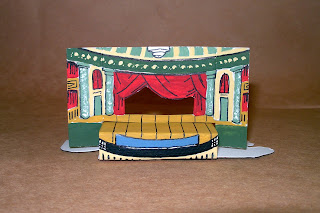Following is the entire piece originally published in the November 1, 1845 edition of the Broadway Journal:
The well-known company of rats at the Park Theatre understand, it is said, their cue perfectly. It is worth the price of admission to see their performance. By long training they know precisely the time when the curtain rises, and the exact degree in which the audience is spellbound by what is going on. At the sound of the bell they sally out; scouring the pit for chance peanuts and orange-peel. When, by the rhyming couplets, they are made aware that the curtain is about to fall, they disappear – through respect for the moving heels of the audience. Their temerity is regulated by the intensity of the performers. A profitable engagement might be made, we think, with “the celebrated Dog Billy.”
I was drawn to the “Theatrical Rats” for a variety of reasons. 1. The brevity of the article. 2. It is actually about theatre! 3. It is an actual newspaper piece, as opposed to a poem or a short story. 4. I was looking to work on as wide an array of Poe’s work as possible. I wanted to adapt not just the greatest hits, but some lesser know work. I was looking to find a balance of his essays, poems, and humorous works in addition to the creepy stories. Right now the only thing that seems totally ignored at Poe-Dunk are his works as a mystery writer.
As always, I began with a box of penny matches (2 1/16" x 1 3/8" x 1/2"), and gave it a base coat of white acrylic. The stage and set pieces again are painted in acrylic on the matchbox itself or on poster board.

Because the Park Theatre in the article was a real place, I did a little research to find photos and illustrations of the stage. Wikipedia had a good write up about the history of the theater as well has an excellent drawing of the interior.
Using my computer I adjusted the drawing to the dimensions needed to work with the matchbox. I used transfer paper to draw the proscenium onto poster board.
My image research also turned up a reproduction of a John Searle painting of the stage and auditorium.

The painting allowed me to roughly match up the colors of the stage. I am particularly happy with my recreation of the marble pillars!

Because I didn’t want to handle every story in the same manner, I decided to paint both sides of the matchbox. Flipping over the Park Theatre’s stage would reveal not the box of matches but a rat.
I found my inspiration for the rat at Moduni with the Richard Wetzel created Lucky Pig in a matchbox.





Because the Park Theatre had such a notorious problem with rodents, Mabbott mentions that a number of New York newspapers in the 1840’s had written stories about the rats. I found a variety of images of newspapers from 1845 the year the Poe article was published. I again used my computer to scale the newspapers to a size that would fit into the matchbox. I mounted the images with spray adhesive to poster board and cut them out.

I created a pair of rats by using Elmer’s glue to attach wire tails to the match heads. I made one black and one gray because I wasn't sure what would be the best visual on the tiny stage.

The characters I imagined for the story were a pair of Shakespearean actors playing Ophelia and Hamlet. I also referenced one of the other newspaper stories that Mabbott discusses by creating a rat catcher. The characters are acrylic on watercolor paper and mounted on penny matches.

The rat catcher was referenced from an image of Queen Victoria’s royal rat catcher Jack Black.





























